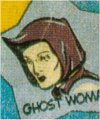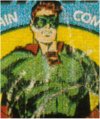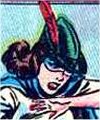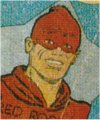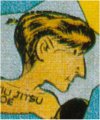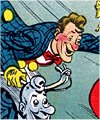Canadian Whites - The Canadian Golden Age Comics
On December 6th 1940, the War Exchange Conservation Act (WECA) was passed
to stabilize the Canadian dollar's value by barring non-essential imports
from the U.S.A. Having declared was on Germany on September 1st 1939 in
response
to the Nazis invading Poland, and aware that tight economic controls would
be key to winning any war, Canada's Foreign Exchange Control Board had
been
established within the same month to ration foreign currency. WECA was
intended
to help minimise the outflow of American currency from Canada by limiting
the importing of non-essential goods from the U.S.A. Comics and pulp
magazines
were amongst the products affected. Naturally this impacted on companies
that had been importing such titles. The obvious option was to publish
their
own comics, and a race began to get beat one another to print first. Most
American titles used four colour printing - every page would have four
plates
of colour (normally black, yellow, cyan and magenta) that when combined
could
produce all the other colours. However, the process to get it right was
costly,
time consuming and difficult to master. While covers remained four colour,
with the new Canadian producers trying to win the race against one
another,
some titles cut their interiors down to the simpler two colour option - a
black plate plus one additional plate of another colour - but most opted
for just black and white. Years later, this prompted collectors of
Canadian
Golden Age titles to call them Canadian Whites, a term was apparently
first
used by Patrick Loubert and Michael Hirsh in their The Great Canadian
Comic Books study of Canadian titles of the era. Initially it was
intended
for use specifically to refer to the indiginous black and white comics,
over
time it has come to be used in the wider form to refer to most any title
published between the imposing of WECA and the lifting of said
restrictions
following the war, including Canadian reprints of U.S. titles published by
Bell and Anglo American; later Anglo American moved to full colour, but
these
titles are still considered "Whites".
The First Four - 1941
Following WECA's implemenation at the end of 1940, four publishers managed
to get their first titles out in 1941, one based in Vancouver and the
other
three in Toronto - Maple Leaf Publishing, Anglo-American Publications,
Hillborough Studios and Commercial Signs of Canada (a.k.a. Bell Features).
Maple Leaf Publishing
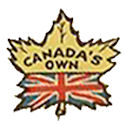 Founded
by
magazine seller Harry Smith, the Vancouver-based Maple Leaf Publications
tied with their rival Anglo-American in the race to get the first title on
the stands, and in March 1941 published Better Comics, which featured
Canada's
first ever home-grown superhero, Iron Man. Subsequent titles included Bing
Bang Comics (launched November-December 1941), Lucky Comics (December
1941)
and Name-It Comics (November-December 1941) which became Rocket Comics
with
#2. Maple Leaf continued publication through the war, and saw WECA end and
American comics returning to Canada. In an attempt to compete, Maple Leaf
went full colour with the intention of exporting outside of Canada, but
they
failed to gain a foothold, and folded in late 1946.
Founded
by
magazine seller Harry Smith, the Vancouver-based Maple Leaf Publications
tied with their rival Anglo-American in the race to get the first title on
the stands, and in March 1941 published Better Comics, which featured
Canada's
first ever home-grown superhero, Iron Man. Subsequent titles included Bing
Bang Comics (launched November-December 1941), Lucky Comics (December
1941)
and Name-It Comics (November-December 1941) which became Rocket Comics
with
#2. Maple Leaf continued publication through the war, and saw WECA end and
American comics returning to Canada. In an attempt to compete, Maple Leaf
went full colour with the intention of exporting outside of Canada, but
they
failed to gain a foothold, and folded in late 1946.
Anglo-American Publishing
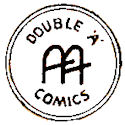 Anglo-American
tied
with Maple Leaf by getting their first title out in March 1941, despite
having a slight advantage that their title, Robin Hood, was a pre-existing
Canadian newspaper strip (Robin Hood and Company) previously published in
the Toronto Evening Telegram. The strip's writer, Ted McCall, approached
Thomas Harold Sinnott of Sinnott News, who had a printing press able to
print
comics, and offered him the printing plates for the series, allowing them
to rapidly reformat them to publish the strip in tabloid size. While
Sinnott
enlisted fellow money men John M. Calder, John G. Baker and Edward C.
Johnston to finance the company, McCall recruited artist Ed Furness
to help him create new strips. After a year of reprints, McCall and
Furness'
new strips began publication, introducing Freelance, Commander Steel and
Red Rover. Anglo-American eventually shut up shop in 1947.
Anglo-American
tied
with Maple Leaf by getting their first title out in March 1941, despite
having a slight advantage that their title, Robin Hood, was a pre-existing
Canadian newspaper strip (Robin Hood and Company) previously published in
the Toronto Evening Telegram. The strip's writer, Ted McCall, approached
Thomas Harold Sinnott of Sinnott News, who had a printing press able to
print
comics, and offered him the printing plates for the series, allowing them
to rapidly reformat them to publish the strip in tabloid size. While
Sinnott
enlisted fellow money men John M. Calder, John G. Baker and Edward C.
Johnston to finance the company, McCall recruited artist Ed Furness
to help him create new strips. After a year of reprints, McCall and
Furness'
new strips began publication, introducing Freelance, Commander Steel and
Red Rover. Anglo-American eventually shut up shop in 1947.
They also licensed the rights to
Fawcett characters. Since WECA
prevented
the comics being imported, Anglo-American took the scripts and had local
artists illustrate them. Amongst the characters who turned up, often with
Canadian touches added to their costumes, were
Bulletman,
Spy-Smasher, Captain
Marvel, Captain Marvel Jnr and
Commando Yank.
Hillborough Studios
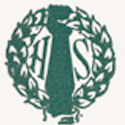 Hillborough
Studios
was the third publisher to get a comic to the stands, Triumph-Adventure
Comics in August 1941. It was founded by Adrian Dingle and the brothers
André and René Kubach, all artists, backed by an anonymous
investor. Alongside less memorable characters such as the pilot Spanner
Preston
and Tang the Wonder Horse, Triumph-Adventure introduced one of the most
significant of all Canadian heroes, Nelvana. Hillsborough's limited
finances
saw their titles only having two-colour covers, andnthey managed to
publish
only six issues of Triumph-Adventure and one of Top Flight Comics before
the company collapsed in February 1942. However, Cy Bell of the rival
company
Bell Features saw the worth in Dingle's work, and hired Dingle as his art
director, adding Triumph (and Nelvana) to his company's line-up.
Hillborough
Studios
was the third publisher to get a comic to the stands, Triumph-Adventure
Comics in August 1941. It was founded by Adrian Dingle and the brothers
André and René Kubach, all artists, backed by an anonymous
investor. Alongside less memorable characters such as the pilot Spanner
Preston
and Tang the Wonder Horse, Triumph-Adventure introduced one of the most
significant of all Canadian heroes, Nelvana. Hillsborough's limited
finances
saw their titles only having two-colour covers, andnthey managed to
publish
only six issues of Triumph-Adventure and one of Top Flight Comics before
the company collapsed in February 1942. However, Cy Bell of the rival
company
Bell Features saw the worth in Dingle's work, and hired Dingle as his art
director, adding Triumph (and Nelvana) to his company's line-up.
Commercial Signs of Canada/ Bell Features
 Toronto
commercial
art company Commerical Signs of Canada was established in the
1930s by brothers Cy and Gene Bell. In 1939 artist Edmund Legault
suggested
they start up their own comic company, but it wasn't until WECA was passed
that Cy agreed. Getting additional financial backing from John Ervin,
Commercial
Signs of Canada became the fourth company to get a comic out, launching
Wow
Comics in September 1941, featuring the space adventurer Whiz Wallace and
pirate cover star Dart Daring. Cy renamed the company Bell Features around
May 1942, roughly the same time he hired Adrian Dingle to be his art
director.
Bell proved to be the longest lasting of all the original four Canadian
publishers.
Toronto
commercial
art company Commerical Signs of Canada was established in the
1930s by brothers Cy and Gene Bell. In 1939 artist Edmund Legault
suggested
they start up their own comic company, but it wasn't until WECA was passed
that Cy agreed. Getting additional financial backing from John Ervin,
Commercial
Signs of Canada became the fourth company to get a comic out, launching
Wow
Comics in September 1941, featuring the space adventurer Whiz Wallace and
pirate cover star Dart Daring. Cy renamed the company Bell Features around
May 1942, roughly the same time he hired Adrian Dingle to be his art
director.
Bell proved to be the longest lasting of all the original four Canadian
publishers.
Educational Projects of Montreal
Publisher Harry J. Halperin was a late addition to the Canadian publishing
houses with his Educational Projects of Montreal, becoming the fifth to go
to print. Unlike his counterparts producing fictional adventures,
Educational
was intended to teach, and so its titles, notably Canadian Heroes
(launched
October 1942), featured biographical tales of real life individuals with
notable achievements, be they Mounties, inventors, sportsmen, explorers,
politicians, etc. However, to boost sales to younger readers looking for
larger-then-life exploits, they decided to include one fictional hero.
Artist
George Rae suggested an adventurer akin to Freelance or Johnny Canuck, and
so Canada Jack was born. He even had his own real life fan club, which
readers
were encouraged to join.
Feature Publications
In late 1943 Bell Features' Edward Schecter launched the Toronto-based
Feature
Publications. The sixth Canadian Whites publisher, it ultimately only
produced
a single title, Lightning Comics, which lasted 12 issues, the last dated
December 1944/January 1945.
F.E. Howard
Superior Publishers
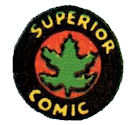 Another
Toronto
company, William Zimmerman's Superior Publishers had begun publishing
pulp magazines shortly after WECA took force, but didn't get into comics
until 1944. Unlike many of their competitors, who were devastated when
American
imports resumed, Superior handled the return better than most, and by 1946
were still active, producing their own material and reprinting American
titles,
including taking the character Zor from F.E. Howard.
Another
Toronto
company, William Zimmerman's Superior Publishers had begun publishing
pulp magazines shortly after WECA took force, but didn't get into comics
until 1944. Unlike many of their competitors, who were devastated when
American
imports resumed, Superior handled the return better than most, and by 1946
were still active, producing their own material and reprinting American
titles,
including taking the character Zor from F.E. Howard.
Magazine Enterprises of Canada
Back to Canadian Superheroes Main Page
Home
All images and characters depicted on this site are copyright their
respective
holders, and are used for informational purposes only. No infringement is
intended and copyrights remain at source.
 Founded
by
magazine seller Harry Smith, the Vancouver-based Maple Leaf Publications
tied with their rival Anglo-American in the race to get the first title on
the stands, and in March 1941 published Better Comics, which featured
Canada's
first ever home-grown superhero, Iron Man. Subsequent titles included Bing
Bang Comics (launched November-December 1941), Lucky Comics (December
1941)
and Name-It Comics (November-December 1941) which became Rocket Comics
with
#2. Maple Leaf continued publication through the war, and saw WECA end and
American comics returning to Canada. In an attempt to compete, Maple Leaf
went full colour with the intention of exporting outside of Canada, but
they
failed to gain a foothold, and folded in late 1946.
Founded
by
magazine seller Harry Smith, the Vancouver-based Maple Leaf Publications
tied with their rival Anglo-American in the race to get the first title on
the stands, and in March 1941 published Better Comics, which featured
Canada's
first ever home-grown superhero, Iron Man. Subsequent titles included Bing
Bang Comics (launched November-December 1941), Lucky Comics (December
1941)
and Name-It Comics (November-December 1941) which became Rocket Comics
with
#2. Maple Leaf continued publication through the war, and saw WECA end and
American comics returning to Canada. In an attempt to compete, Maple Leaf
went full colour with the intention of exporting outside of Canada, but
they
failed to gain a foothold, and folded in late 1946.
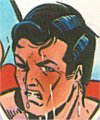

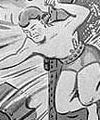
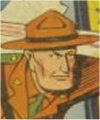
 Anglo-American
tied
with Maple Leaf by getting their first title out in March 1941, despite
having a slight advantage that their title, Robin Hood, was a pre-existing
Canadian newspaper strip (Robin Hood and Company) previously published in
the Toronto Evening Telegram. The strip's writer, Ted McCall, approached
Thomas Harold Sinnott of Sinnott News, who had a printing press able to
print
comics, and offered him the printing plates for the series, allowing them
to rapidly reformat them to publish the strip in tabloid size. While
Sinnott
enlisted fellow money men John M. Calder, John G. Baker and Edward C.
Johnston to finance the company, McCall recruited artist Ed Furness
to help him create new strips. After a year of reprints, McCall and
Furness'
new strips began publication, introducing Freelance, Commander Steel and
Red Rover. Anglo-American eventually shut up shop in 1947.
Anglo-American
tied
with Maple Leaf by getting their first title out in March 1941, despite
having a slight advantage that their title, Robin Hood, was a pre-existing
Canadian newspaper strip (Robin Hood and Company) previously published in
the Toronto Evening Telegram. The strip's writer, Ted McCall, approached
Thomas Harold Sinnott of Sinnott News, who had a printing press able to
print
comics, and offered him the printing plates for the series, allowing them
to rapidly reformat them to publish the strip in tabloid size. While
Sinnott
enlisted fellow money men John M. Calder, John G. Baker and Edward C.
Johnston to finance the company, McCall recruited artist Ed Furness
to help him create new strips. After a year of reprints, McCall and
Furness'
new strips began publication, introducing Freelance, Commander Steel and
Red Rover. Anglo-American eventually shut up shop in 1947.
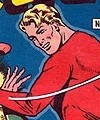
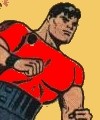
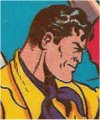
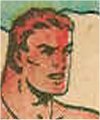
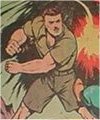
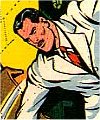
 Hillborough
Studios
was the third publisher to get a comic to the stands, Triumph-Adventure
Comics in August 1941. It was founded by Adrian Dingle and the brothers
André and René Kubach, all artists, backed by an anonymous
investor. Alongside less memorable characters such as the pilot Spanner
Preston
and Tang the Wonder Horse, Triumph-Adventure introduced one of the most
significant of all Canadian heroes, Nelvana. Hillsborough's limited
finances
saw their titles only having two-colour covers, andnthey managed to
publish
only six issues of Triumph-Adventure and one of Top Flight Comics before
the company collapsed in February 1942. However, Cy Bell of the rival
company
Bell Features saw the worth in Dingle's work, and hired Dingle as his art
director, adding Triumph (and Nelvana) to his company's line-up.
Hillborough
Studios
was the third publisher to get a comic to the stands, Triumph-Adventure
Comics in August 1941. It was founded by Adrian Dingle and the brothers
André and René Kubach, all artists, backed by an anonymous
investor. Alongside less memorable characters such as the pilot Spanner
Preston
and Tang the Wonder Horse, Triumph-Adventure introduced one of the most
significant of all Canadian heroes, Nelvana. Hillsborough's limited
finances
saw their titles only having two-colour covers, andnthey managed to
publish
only six issues of Triumph-Adventure and one of Top Flight Comics before
the company collapsed in February 1942. However, Cy Bell of the rival
company
Bell Features saw the worth in Dingle's work, and hired Dingle as his art
director, adding Triumph (and Nelvana) to his company's line-up. 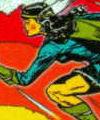
 Toronto
commercial
art company Commerical Signs of Canada was established in the
1930s by brothers Cy and Gene Bell. In 1939 artist Edmund Legault
suggested
they start up their own comic company, but it wasn't until WECA was passed
that Cy agreed. Getting additional financial backing from John Ervin,
Commercial
Signs of Canada became the fourth company to get a comic out, launching
Wow
Comics in September 1941, featuring the space adventurer Whiz Wallace and
pirate cover star Dart Daring. Cy renamed the company Bell Features around
May 1942, roughly the same time he hired Adrian Dingle to be his art
director.
Bell proved to be the longest lasting of all the original four Canadian
publishers.
Toronto
commercial
art company Commerical Signs of Canada was established in the
1930s by brothers Cy and Gene Bell. In 1939 artist Edmund Legault
suggested
they start up their own comic company, but it wasn't until WECA was passed
that Cy agreed. Getting additional financial backing from John Ervin,
Commercial
Signs of Canada became the fourth company to get a comic out, launching
Wow
Comics in September 1941, featuring the space adventurer Whiz Wallace and
pirate cover star Dart Daring. Cy renamed the company Bell Features around
May 1942, roughly the same time he hired Adrian Dingle to be his art
director.
Bell proved to be the longest lasting of all the original four Canadian
publishers.
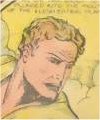
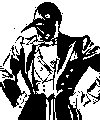
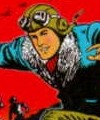
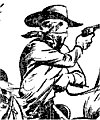
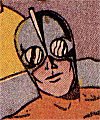
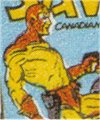
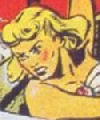
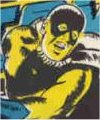
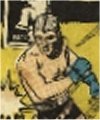
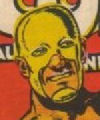
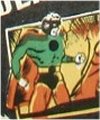
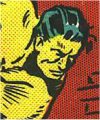
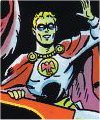
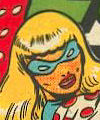
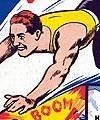
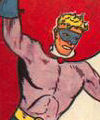
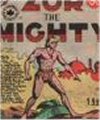
 Another
Toronto
company, William Zimmerman's Superior Publishers had begun publishing
pulp magazines shortly after WECA took force, but didn't get into comics
until 1944. Unlike many of their competitors, who were devastated when
American
imports resumed, Superior handled the return better than most, and by 1946
were still active, producing their own material and reprinting American
titles,
including taking the character Zor from F.E. Howard.
Another
Toronto
company, William Zimmerman's Superior Publishers had begun publishing
pulp magazines shortly after WECA took force, but didn't get into comics
until 1944. Unlike many of their competitors, who were devastated when
American
imports resumed, Superior handled the return better than most, and by 1946
were still active, producing their own material and reprinting American
titles,
including taking the character Zor from F.E. Howard. 